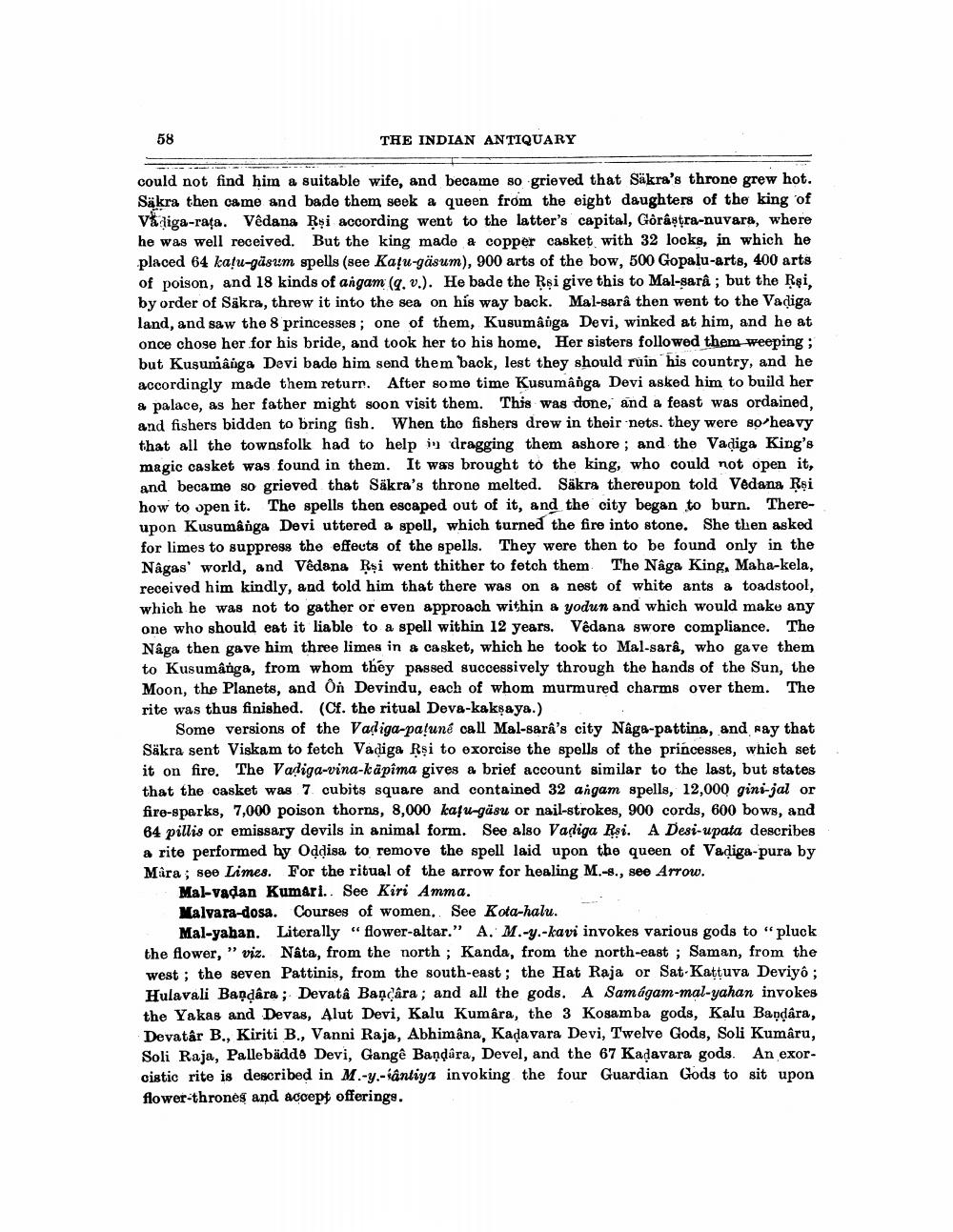________________
58
THE INDIAN ANTIQUARY
could not find him a suitable wife, and became so grieved that Säkra's throne grew hot. Säkra then came and bade them seek a queen from the eight daughters of the king of Vadiga-rata. Vêdana Ṛsi according went to the latter's capital, Gôrâstra-nuvara, where he was well received. But the king made a copper casket with 32 locks, in which he placed 64 katu-gäsum spells (see Katu-gäsum), 900 arts of the bow, 500 Gopalu-arts, 400 arts of poison, and 18 kinds of angam (q. v.). He bade the Ṛși give this to Mal-sarâ ; but the Ṛși, by order of Säkra, threw it into the sea on his way back. Mal-sarâ then went to the Vaḍiga land, and saw the 8 princesses; one of them, Kusumâiga Devi, winked at him, and he at once chose her for his bride, and took her to his home. Her sisters followed them weeping; but Kusumanga Devi bade him send them back, lest they should ruin his country, and he accordingly made them return. After some time Kusumanga Devi asked him to build her a palace, as her father might soon visit them. This was done, and a feast was ordained, and fishers bidden to bring fish. When the fishers drew in their nets. they were so heavy that all the townsfolk had to help in dragging them ashore; and the Vadiga King's magic casket was found in them. It was brought to the king, who could not open it, and became so grieved that Säkra's throne melted. Säkra thereupon told Vedana Ṛṣi how to open it. The spells then escaped out of it, and the city began to burn. Thereupon Kusumâiga Devi uttered a spell, which turned the fire into stone. She then asked for limes to suppress the effects of the spells. They were then to be found only in the Nâgas' world, and Vêdana Ṛsi went thither to fetch them The Nâga King, Maha-kela, received him kindly, and told him that there was on a nest of white ants a toadstool, which he was not to gather or even approach within a yodun and which would make any one who should eat it liable to a spell within 12 years. Vêdana swore compliance. The Nâga then gave him three limes in a casket, which he took to Mal-sarâ, who gave them to Kusumanga, from whom they passed successively through the hands of the Sun, the Moon, the Planets, and On Devindu, each of whom murmured charms over them. The rite was thus finished. (Cf. the ritual Deva-kakṣaya.)
Some versions of the Vadiga-patuné call Mal-sara's city Nâga-pattina, and say that Säkra sent Viskam to fetch Vadiga Ṛsi to exorcise the spells of the princesses, which set it on fire. The Vadiga-vina-kapima gives a brief account similar to the last, but states that the casket was 7 cubits square and contained 32 angam spells, 12,000 gini-jal or fire-sparks, 7,000 poison thorns, 8,000 kafu-gäsu or nail-strokes, 900 cords, 600 bows, and 64 pillis or emissary devils in animal form. See also Vadiga Rsi. A Desi-upata describes a rite performed by Oḍdisa to remove the spell laid upon the queen of Vaḍiga-pura by Mara; see Limes. For the ritual of the arrow for healing M.-s., see Arrow.
Mal-vadan Kumari.. See Kiri Amma.
Malvara-dosa. Courses of women. See Kota-halu.
Mal-yahan. Literally "flower-altar." A. M.-y.-kavi invokes various gods to "pluck the flower," viz. Nâta, from the north; Kanda, from the north-east; Saman, from the west; the seven Pattinis, from the south-east; the Hat Raja or Sat-Kattuva Deviyô; Hulavali Baṇḍâra; Devatâ Bançâra; and all the gods. A Samagam-mal-yahan invokes the Yakas and Devas, Alut Devi, Kalu Kumâra, the 3 Kosamba gods, Kalu Bandara, Devatâr B., Kiriti B., Vanni Raja, Abhimâna, Kadavara Devi, Twelve Gods, Soli Kumaru, Soli Raja, Pallebädds Devi, Gangê Bandara, Devel, and the 67 Kadavara gods. An exorcistic rite is described in M.-y.-ântiya invoking the four Guardian Gods to sit upon flower-thrones and accept offerings.




